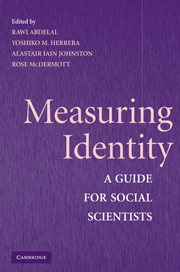Book contents
- Frontmatter
- Contents
- Contributors
- Introduction
- I DEFINITION, CONCEPTUALIZATION, AND MEASUREMENT ALTERNATIVES
- II SURVEY METHODS
- 4 Between Social Theory and Social Science Practice: Toward a New Approach to the Survey Measurement of “Race”
- 5 Balancing National and Ethnic Identities: The Psychology of E Pluribus Unum
- 6 Black and Blue: Black Identity and Black Solidarity in an Era of Conservative Triumph
- III CONTENT ANALYSIS AND COGNITIVE MAPPING
- IV DISCOURSE ANALYSIS AND ETHNOGRAPHY
- V EXPERIMENTS
- Bibliography
- Index
4 - Between Social Theory and Social Science Practice: Toward a New Approach to the Survey Measurement of “Race”
Published online by Cambridge University Press: 05 June 2012
- Frontmatter
- Contents
- Contributors
- Introduction
- I DEFINITION, CONCEPTUALIZATION, AND MEASUREMENT ALTERNATIVES
- II SURVEY METHODS
- 4 Between Social Theory and Social Science Practice: Toward a New Approach to the Survey Measurement of “Race”
- 5 Balancing National and Ethnic Identities: The Psychology of E Pluribus Unum
- 6 Black and Blue: Black Identity and Black Solidarity in an Era of Conservative Triumph
- III CONTENT ANALYSIS AND COGNITIVE MAPPING
- IV DISCOURSE ANALYSIS AND ETHNOGRAPHY
- V EXPERIMENTS
- Bibliography
- Index
Summary
INTRODUCTION
The idea that a person's “race” is not the indelible mark of one's bloodline, phenotype, or some other biologistic notion no longer raises eyebrows, but it remains for the most part politely ignored by quantitatively oriented, survey-based social science researchers. Although we acknowledge that race, like ethnicity, is a social construct marked by fluidity, multiplicity, and contingency, we continue to measure racial and ethnic identities as fixed, categorical variables. This gap between theory and practice may be consequential if indeed it is the case that a fluid, continuous reality is measured in fixed, categorical terms. In this chapter, a new approach to measuring ethnoracial self-identification is presented, one that aims to define the parameters of this gap by explicitly taking variations in racial or ethnic self-identification as the object of inquiry.
Specifically, the chapter compares the standard approach to ethnoracial self-identification in surveys against a new measurement approach in which respondents are given “identity points” to allocate across a relevant set of social identity categories. This identity point allocation scheme allows respondents, as they see fit, to identify with as many racial or ethnic groups and to weight the strength of their self-identification across these groups. This new approach not only allows us to test for the sensitivity of ethnoracial self-identification to a question format but, in doing so, also presents a visibly different portrait of racial or ethnic self-identification than is found in most social surveys.
- Type
- Chapter
- Information
- Measuring IdentityA Guide for Social Scientists, pp. 113 - 144Publisher: Cambridge University PressPrint publication year: 2009
- 11
- Cited by



